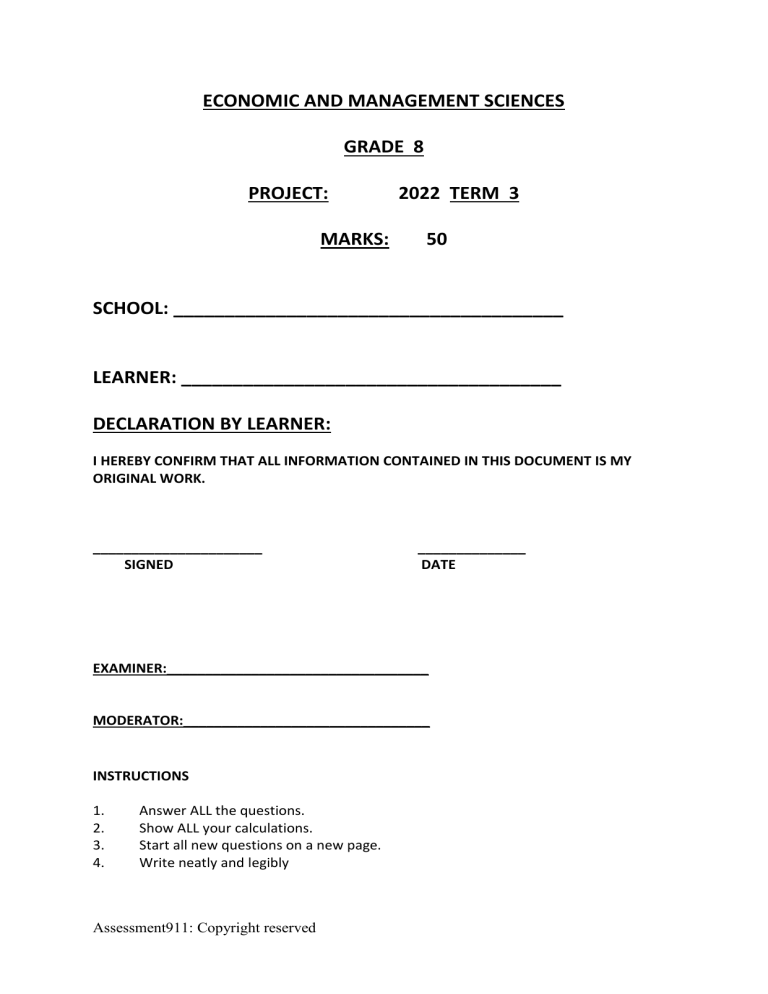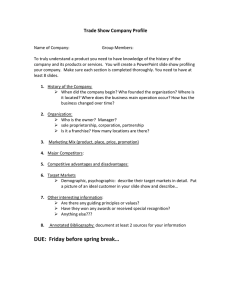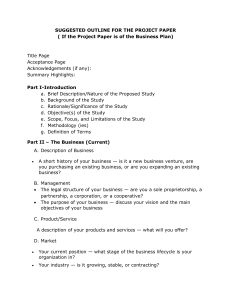
ECONOMIC AND MANAGEMENT SCIENCES GRADE 8 PROJECT: MARKS: 2022 TERM 3 50 SCHOOL: ______________________________________ LEARNER: _____________________________________ DECLARATION BY LEARNER: I HEREBY CONFIRM THAT ALL INFORMATION CONTAINED IN THIS DOCUMENT IS MY ORIGINAL WORK. ______________________ SIGNED ______________ DATE EXAMINER:__________________________________ MODERATOR:________________________________ INSTRUCTIONS 1. 2. 3. 4. Answer ALL the questions. Show ALL your calculations. Start all new questions on a new page. Write neatly and legibly Assessment911: Copyright reserved Minimum Requirements for a Project * * * * * * A Cover Page A Table of Contents Text divided into paragraphs/sections with headings and sub-headings. Pictures, Photos, Diagrams and Graphs may be included Include a Bibliography using the Harvard Method of Referencing The project should be bound or stapled ENTREPRENEURSHIP TOPIC FOR PROJECT: FORMS OF OWNERSHIP Write an essay of 3-4 pages in which you analyse and discuss various factors related to different forms of business ownership. Follow the guidelines below to write the essay. Your essay must include, but is not limited to, the following aspects. 1. An introduction in which you briefly describe four different forms of ownership for a South African business and discuss the importance of choosing the right form of ownership for any business. (10) 2. Analyse and discuss the characteristics, advantages and disadvantages of a sole trader. (15) 3. Give two motivated reasons why you would choose or not choose a sole trader as a form of ownership for a small to medium enterprise. (5) Conduct an interview with any business owner and: (10) 4. 4.1 4.2 4.3 4.4 State the name of the business owner, the name of the business and a telephone number; What type of ownership is this business? Summarise why the owner chose this type of ownership; Give your motivated opinion if this business owner made the right choice of form of ownership. 6. End your project with a summary paragraph in which you give a motivated opinion about the dangers of a sole trader as a form of business ownership. (5) 7. Information must be gathered from any resource at your disposal e.g. internet, media, newspapers, magazines, books etc. Use pictures, graphs, tables etc. to make your project more interesting and to support statements that you have made. Compile a bibliography according to the Harvard Method of Referencing. (5) Your project will be marked according to the following rubric: – Make sure you cover all the aspects mentioned! PROJECT TOTAL: 50 MARKS Assessment911: Copyright reserved HARVARD METHOD OF REFERENCING BOOK Smith, A (2010). Grade 7 Life Orientation. Johannesburg: Oxford University Press. p. 26-28. JOURNAL ARTICLE Smith, A. (2011). Environmental Issues. Green Earth. 5 (2), p. 179-314. WEBSITE Smith, A. (2009). Pollution! Available: http://www.greenearth.com/. Last accessed 10 June 2014. EMAIL Smith, A. water@love_our_earth.co.za. Cleaning Up. 22 March 2017. Your project will be marked according to the following rubric: – Make sure you cover all the aspects mentioned! PROJECT TOTAL: 50 MARKS Assessment911: Copyright reserved Introduction Characteristics, advantages and disadvantages Motivated choice Business owner interview Concluding end paragraph. Bibliography Neatness. EXCELLENT GOOD SATISFACTORY NEEDS IMPROVEMENT 8-10 Excellent introduction and knowledge of 4 forms of ownership and understanding of importance to make correct choice 12-15 6-7 Good introduction and knowledge of 4 forms of ownership and understanding of importance to make correct choice 9-11 Good to very good understanding of characteristics, advantages and disadvantages of a sole trader 4 Good to very good insight shown in motivated reasons for or against choosing a sole trader as a form of ownership 6-7 Most relevant information gathered. Good to very good analysis if right choice was made – motivated opinion 6-7 Good end paragraph & conclusion. Sources used and mostly correct bibliography format. 4-5 0-3 Satisfactory introduction and knowledge of 2+ forms of ownership and understanding of importance to make correct choice None to poor introduction and knowledge of 1/2 forms of ownership. 5-8 0-4 Satisfactory and motivated understanding of characteristics, advantages and disadvantages of a sole trader None to poor understanding of characteristics, advantages and disadvantages of a sole trader 2-3 0-1 Acceptable to satisfactory insight shown in motivated reasons for or against choosing a sole trader as a form of ownership None to poor insight shown in reasons for or against choosing a sole trader as a form of ownership 4-5 0-3 Adequate relevant information gathered. Acceptable analysis if right choice was made – motivated opinion None to little information gathered. None to poor analysis if right choice was made 4-5 Satisfactory end paragraph & conclusion. Some sources used and attempt at correct bibliography format. 0-3 None to poor end paragraph & conclusion. None or poor sources used and incorrect bibliography format. Excellent understanding of characteristics, advantages and disadvantages of a sole trader 5 Excellent insight shown in motivated reasons for or against choosing a sole trader as a form of ownership 8-10 All relevant information gathered. Excellent analysis if right choice was made – motivated opinion 8-10 Excellent end paragraph & conclusion. Sources used and correct bibliography format. Assessment911: Copyright reserved 10 15 5 10 10 Reference material may be distributed at educator’s discretion. Sole Proprietorship A sole proprietorship is a business that is owned and operated by a natural person (individual). This is the simplest form of business entity. The sole proprietorship is not a legal entity. The business has no existence separate from the owner who is called the proprietor. The owner must include the income from such business in his or her own income tax return and is responsible for the payment of taxes thereon. A sole proprietorship can operate under the name of its owner or it can do business under a fictitious name. The fictitious name is simply a trade name–it does not create a legal entity separate from the sole proprietor owner. Only the proprietor has the authority to make decisions for the business. The proprietor assumes the risks of the business to the extent of all of his or her assets whether used in the business or not. Some advantages Some disadvantages Simple to establish and operate Unlimited liability of the owner The owner is legally liable for all the debts of the business. Not only the investment or business property, but any personal and fixed property may be attached by creditors. The owner signs contracts in his or her own name, because the sole proprietorship has no separate identity under the law. Owner is free to make decisions Limited ability to raise capital The business capital is limited to whatever the owner can personally secure. This limits the expansion of a business when new capital is required. A common cause for failure of this form of business organisation is a lack of funds. This restricts the ability of a sole proprietor (owner) to operate the business effectively and survive at an initial low profit level, or to get through an economic “rough spot Minimum of legal requirements Limited skills One owner alone has limited skills, although he or she may be able to hire employees with sought-after skills. Owner receives all the profits Easy to discontinue the business https://www.sars.gov.za/businesses-and-employers/small-businesses-taxpayers/starting-a-businessand-tax/sole-proprietorship/ Assessment911: Copyright reserved Advantages and disadvantages of sole proprietorship Provided by Business Partners Ltd, South Africa's leading investor in SMEs When you are deciding what kind of business to open, it's important to have the most appropriate format for practical, legal and tax purposes. Is a sole proprietorship right for you? Let's find out. A sole proprietorship is the simplest kind of independent business, as it doesn't need to be registered as a legal entity. You can only choose this option if you're a single owner, though, whether or not you employ or contract other people during the course of your work. A sole proprietorship is often the ideal choice for a professional in private practice, a guest house owner, or the owner of a small craft business, for example. For many, the advantages outweigh the disadvantages, as long as the business is carefully managed. Advantages Of A Sole Proprietorship It's a simple format to set up and manage, as it doesn't have to be legally registered It's suitable for a single owner, whether or not he or she employs or contracts other people You can start trading under your own name or a trading name immediately You do not have to separate your own finances of those of the business (since you are the business), and you are taxed according to personal income tax rates Your only legal and financial obligations are those you have towards yourself Disadvantages Of A Sole Proprietorship As with all coins, there are always two sides. In terms of a sole proprietorship: There's no distinction between the business's assets and the owner's assets You are also responsible to pay any debts and liabilities incurred by the business It may seem that this business format is the easiest and quickest, but it's not necessarily appropriate for you. Going this route when you should be registered as some other legal entity (because of a high turnover, for example) could end up costing you money and red tape along the line. Do enough research and speak to a legal/tax professional in this area to structure your personal and business assets in such a way that you will have some protection should your venture fail. https://smetoolkit.businesspartners.co.za/en/content/advantages-and-disadvantages-soleproprietorship Assessment911: Copyright reserved





